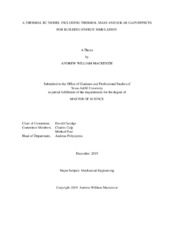A Thermal RC Model Including Thermal Mass and Solar Gain Effects for Building Energy Simulation
Abstract
Building Commissioning is important for evaluating energy and dollar savings in existing buildings. Energy Systems Lab of Texas A&M University has developed WinAM with the purpose of aiding that process. WinAM is a steady-state calculation engine tool that computes energy and dollar savings for commissioning purposes in existing buildings. However, the problem can rise with WinAM’s simplified calculation method rendering inaccurate results. This research proposes a Resistance-Capacitance (RC) model be added to the current WinAM model that incorporates the effects of solar heat gains and thermal mass effects. The RC model is tested against 11 simulation cases with EnergyPlus™, a building energy simulation program, and the current WinAM version. Parameters are changed in all models to analyze the proposed RC model against EnergyPlus results. The results show that the RC model achieves better performance than WinAM when compared to EnergyPlus. The extreme case differs of 286% for annual heating consumption between the RC model and EnergyPlus, while WinAM differs in 4040% for annual heating consumption when compared to EnergyPlus. The RC model annual heating and cooling consumption results approximates better to EnergyPlus in more than 90% of the cases analyzed. Energy savings are estimated for the cases of temperature setback and dead-band temperature set points, for seven different weather conditions and three different building masses. A case study is also analyzed of a real building, each model is calibrated to the building’s metered energy consumption, and applied energy efficiency measures (EEMs) to the models, comparing each model’s estimated savings. For the case study, the estimated savings from all models when temperature set back and temperature dead-band are applied present similar estimated savings. The extreme cases are of WinAM over predicting savings for temperature set back such as 47% for annual heating consumption, while RC predicts 27% and EnergyPlus only predicts 6%, and WinAM under predicting savings for temperature dead-band such as 31% for annual heating consumption, while RC predicts 96%, and EnergyPlus predicts 99% savings. The RC model presents improvement from the current WinAM model in 53/55 of simulated cases of the estimated savings when compared to EnergyPlus estimated savings.
Subject
Building Energy SimulationThermal Mass
Solar Gain
Energy Savings
Savings
Dollar Savings
Commercial Builindg
HVAC
WinAM
EnergyPlus
RC
Thermal Model
Citation
Mackenzie, Andrew William (2019). A Thermal RC Model Including Thermal Mass and Solar Gain Effects for Building Energy Simulation. Master's thesis, Texas A&M University. Available electronically from https : / /hdl .handle .net /1969 .1 /188772.


